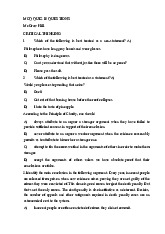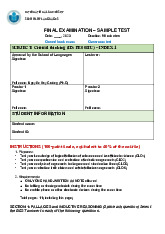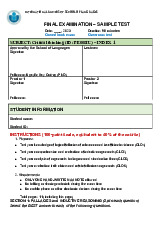















Preview text:
CHAP 5: LOGICAL FALLACIES OF RELEVANCE
FALLACY: An argument that contains mistakes in reasoning
2 TYPES OF FALLACIES: Fallacies of relevance & Fallacies of insucient evidence CONCEPT OF RELEVANCE
- Positively relevant (Premise và conclusion nói về 1 chủ đề và đúng lập luận)
- Negatively relevant (Premise và conclusion nói về 1 chủ đề nhưng lập luận bị sai)
- Logically irrelevant (cả premise và conclusion không nói về cùng 1 chủ đề) N.O
11 FALLACIES OF RELEVANCE EXPLANATIONS EXAMPLES 1 Personal attack (Ad Attacks the person rather
A is a bad person (in one way or hominem) than the issue another). Therefore, his/her opinion or argument must be bad. 2
Attack the motive (assumed Criticizes the arguer’s
X is biased or has questionable
benets/ purpose) (tấn công motivation motives. động cơ) Therefore, X’s argument or
(sub categorical of personal claim should be rejected attack) 3
Look who’s talking (Tu Attacks the arguer because X fails to follow his or her Quoque = And you, too)
she/her fails to practice what advice. she/he preaches Therefore, X’s argument or claim should be rejected. 4 Two wrongs make a right Justies a wrongful act by I did what the other did. So I claiming others are bad or didn’t do anything wrong. worse. 5
Scare tactics (đánh vào nỗi sợ Threatens to harm the của người khác) listener if conclusion not accepted; this threat is irrelevant to arguer’s conclusion 6
Appeal to pity (make us feel Inappropriately appeals to sorry) feelings of pity from the listener or reader 7 Bandwagon argument Makes a claim due to
Everybody (or a majority group) (appeal to popularity)
arguer’s desire to be popular does X. or valued rather than
Therefore, you should believe in, *Crowd psychology appealing to logically or do X, too. relevant evidence 8
Straw man: ngụy biện nhét Misrepresents the original
X’s view is false or unjustied
chữ vào mồm người khác argument to attack the (but it is misinterpreted). arguer easily
Therefore, X’s view should be
Đuối lý, không tấn công rejected
-> Xuyên tạc, bôi nhọ, vu khống Make up a new argument for some one
- Mang nghĩa công kích 9
Red herring (ngụy biện cá Draws attention away the
trích/ ngụy biện đánh trống original point lảng) 10 Equivocation Key words used in two or more sense in the same argument 11
Begging the question (circular Simply restates the reasoning) conclusion or argues in a circles
Vòng vo tam quốc nhưng vẫn về ý cũ
CHAP 6: LOGICAL FALLACIES OF INSUFFICIENT EVIDENCE N.O 10 FALLACIES OF EXPLANATION INSUFFICIENT EVIDENCE 1 Inappropriate appeal to
Authority: citations for credibility/ reliability authority I.
Who can we believe? Sources
1. Are they a true authority/ expert?
2. Are they biased on certain issues?
3. Are they generally reliable? -
Is this website generally trustworthy? 4. Are they cited correctly? II.
What can we believe? Claims/ facts
5. Are the authority’s observations questionable?
6. Does the authority’s opinion disagree with expert consensus?
7. Is the authority’s claim highly improbable? 2 Appeal to ignorance
Arguer claims something is true, because he fails to prove it’s false (or
visa-versa). -> This type of fallacy is synonymous with unwarranted assumptions.
Synonymous with unwarranted assumption 3 False alternatives
Arguer insists that there are fewer choices than there actually are. 4
Loaded question (giống kiểu
A loaded question contains an/some unfair or questionable assumption(s).
hỏi cung, giống cảnh sát investigate)
Loaded questions: Implicit assumptions of guilt
Alternative questions: Narrow down choices, both implying guilt 5
Questionable cause: This
The post hoc fallacy: suggesting that A causes B just because A came
happened after you said that, before B (thứ tự trước sau)
therefore you caused it!
Ex:Isawablackcatonmywaytoschool,thenIwascaughtcheating.The blackcatcausedmybadluck.
Ex:Icouldn’t ndmyearringslastnightandthismorningthemaidwent
out.Sheobviouslytookmyearringsoutforsale!
Mere correlation fallacy: suggesting that the constant occurrences of A
and B entails that they are causally related (tại cái A nên t mới phải bị cái B)
Ex:EverymorningthisweekIateeggs,andeverydayIfailedtheexam.I shouldstopeatingeggs.
Ex:Ican’t ndmyearringsanywhere.Hmm,doyouseethatthesedays, themaidbehavesunnaturally?
Oversimplied cause fallacy: suggesting that A is the cause of B when
clearly B has many causes. (Có 1000 ngàn lý do để xảy ra sự việc đó
nhưng chỉ tập trung suy xét 1 lý do duy nhất)
Ex:Sincethecityincreasedthepresenceofpolice,crimerateshave
greatlydeclinedinreports.Clearly,thisisane ectivepolicyofthe government. 6 Hasty generalization vs
Arguers draw a general conclusion from a sample that is biased or too Composition small.
Biased sample: I polled 100 professors from 100 schools, only 25% of
them believed in God. I guess most Americans don’t believe in God anymore.
Too small sample: I asked my professors if they believed in God, and
only one did. I guess professors don’t believe in God anymore. 7
Division (giống stereotype z)
Assuming that what is true of a group as a whole, as a composite thing,
must be true of every member of that group (stereotype) 8 Slippery slope
Arguers claim, without sucient evidence, that an action will lead to a terrible one.
Common form: A leads to B, and B leads to C, and C to do D, and we really
don’t want D. Thus, we shouldn’t do A. 9 Weak analogy
Arguer compares two (or more) things that aren’t really comparable in the relevant respect. 10 Inconsistency
The arguer makes two logically contradictory claims, or says and does opposite things. Common form: A and not A CHAP 7: ANALYZING ARGUMENTS
DIAGRAMMING SHORT ARGUMENTS: -
Read through the argument and circle any premise or conclusion indicators -
Number the statement consecutively as they appear in the argument -
Arrange the numbers on a page with premises placed above the conclusions they are claimed to support -
Using arrows to mean “is oered as evidence for”, create a kind of owchart that
indicates relationships of argumentative support Premise indicator words:
therefore, thus, hence, consequently, so, accordingly,
since, because, for, given that, seeing that, considering
it follows that, for this reason, that is why, which
that, inasmuch as, as, in view of the fact that, as
shows that, wherefore, this implies that, as a result,
indicated by, judging from, on account of
this suggests that, this being so, we may infer that, etc. Identify (circle, underline, etc.) all premise and / or conclusion indicators. Number the statements consecutively as they appear in the argument. Arrange the numbers on a page with the premises placed above the conclusion(s) they claim to support.
Omit any logically irrelevant statements. Use arrows to mean ‘is oered as evidence for’ to show the relationship of argument support. EXAMPLES:
CHAP 8: EVALUATING ARGUMENTS AND REFUTING ARGUMENTS I. EVALUATING ARGUMENT: -
Once an argument is summarized/standardized, you need to evaluate it so that you
can decide whether or not to accept the conclusion. -
Two main questions to evaluate:
+ Is the argument a good argument? + Are the premises acceptable? - A good argument mean:
+ Deductively sound: true conclusion following true premises
+ Inductively cogent: probably true conclusion following true premises -
8 standards of a good arguments: II. REFUTING ARGUMENT:
1. Show that a premise - or a group of premises - is false or dubious (vague, doubtful). a) Refutingdeductiveargument: -
Missing completeness: All American presidents live in the White House. -
Missing clarity: Paris Hilton is President. (business president? Any organization’s president?) b) Refutinginductiveargument
->Showinsu cientpremisesfortheconclusion c) Refutingaclaim: -
Reduceto the absurd:show that a statement is false by proving that it logically
implies something that is clearly false or absurd. -
Provide a counter-example:an example that proves that a general claim is false
d) Refutingfallaciousargument:You need to show that the argument is either (a)
deductively invalid or (b) inductively weak. -
Show that the conclusion does not follow from the premises: + Are the premises relevant?
+ If not, show fallacies of relevance
+ Are the premises sucient to support the conclusion?
+ If not, show fallacies of insucient evidence




